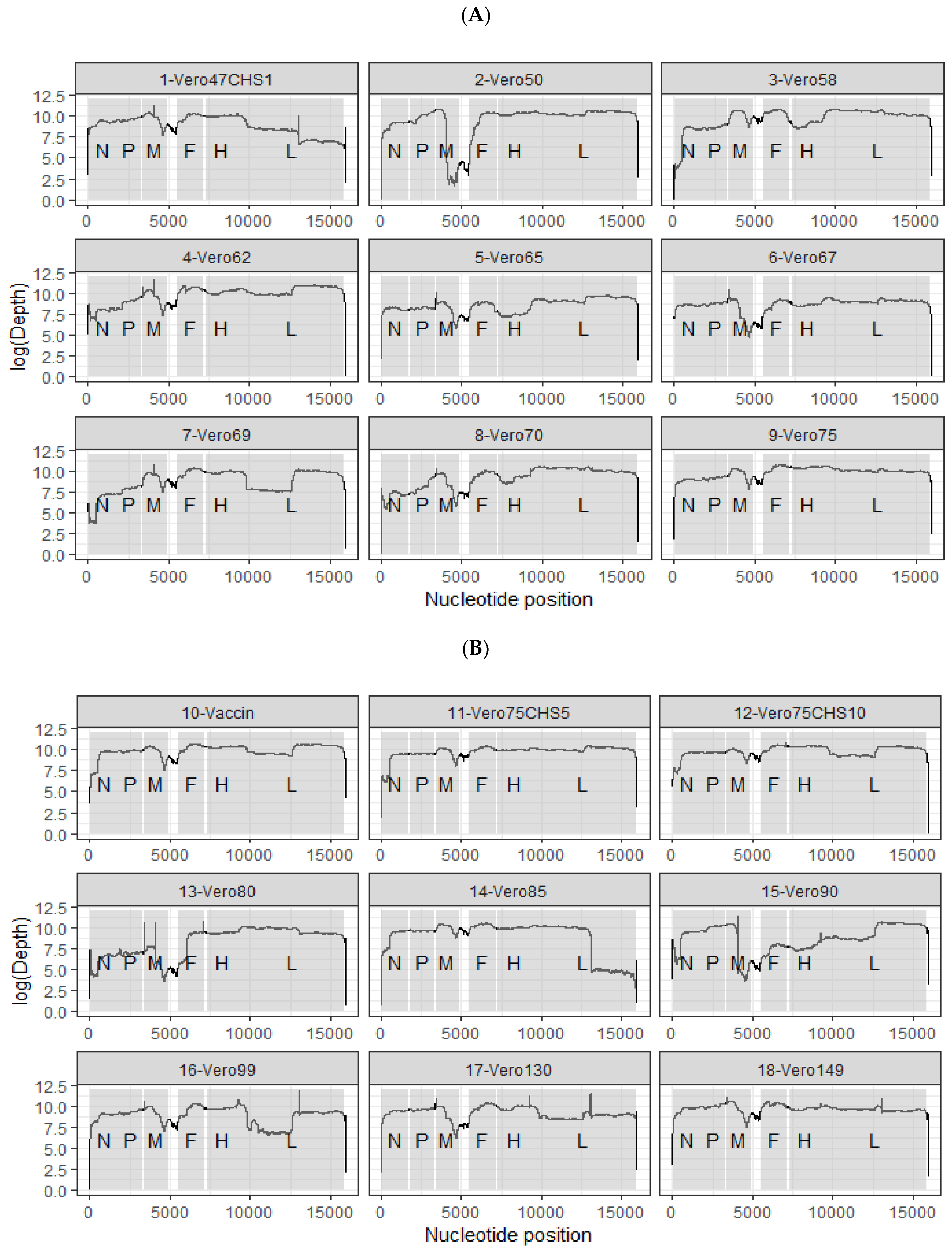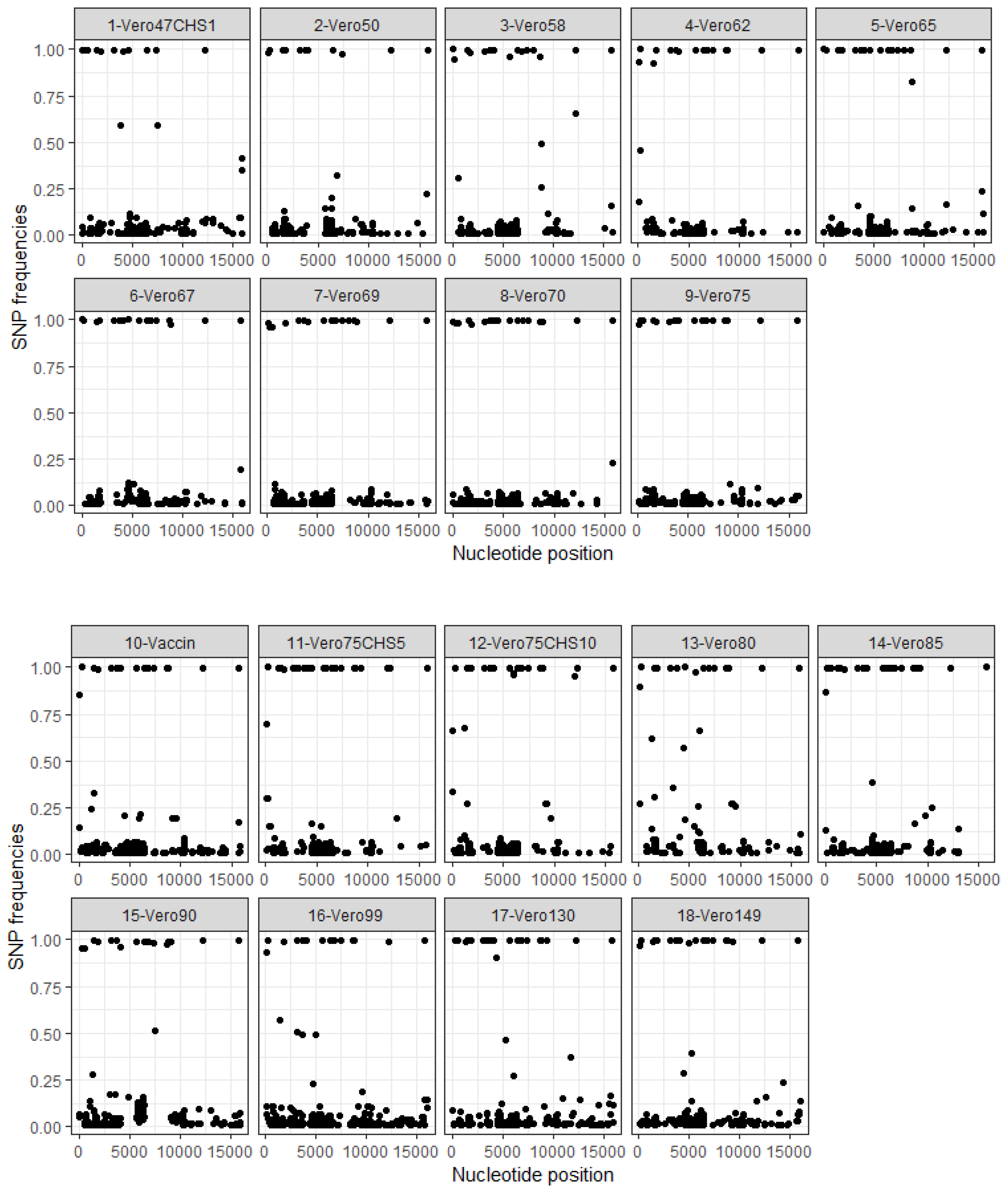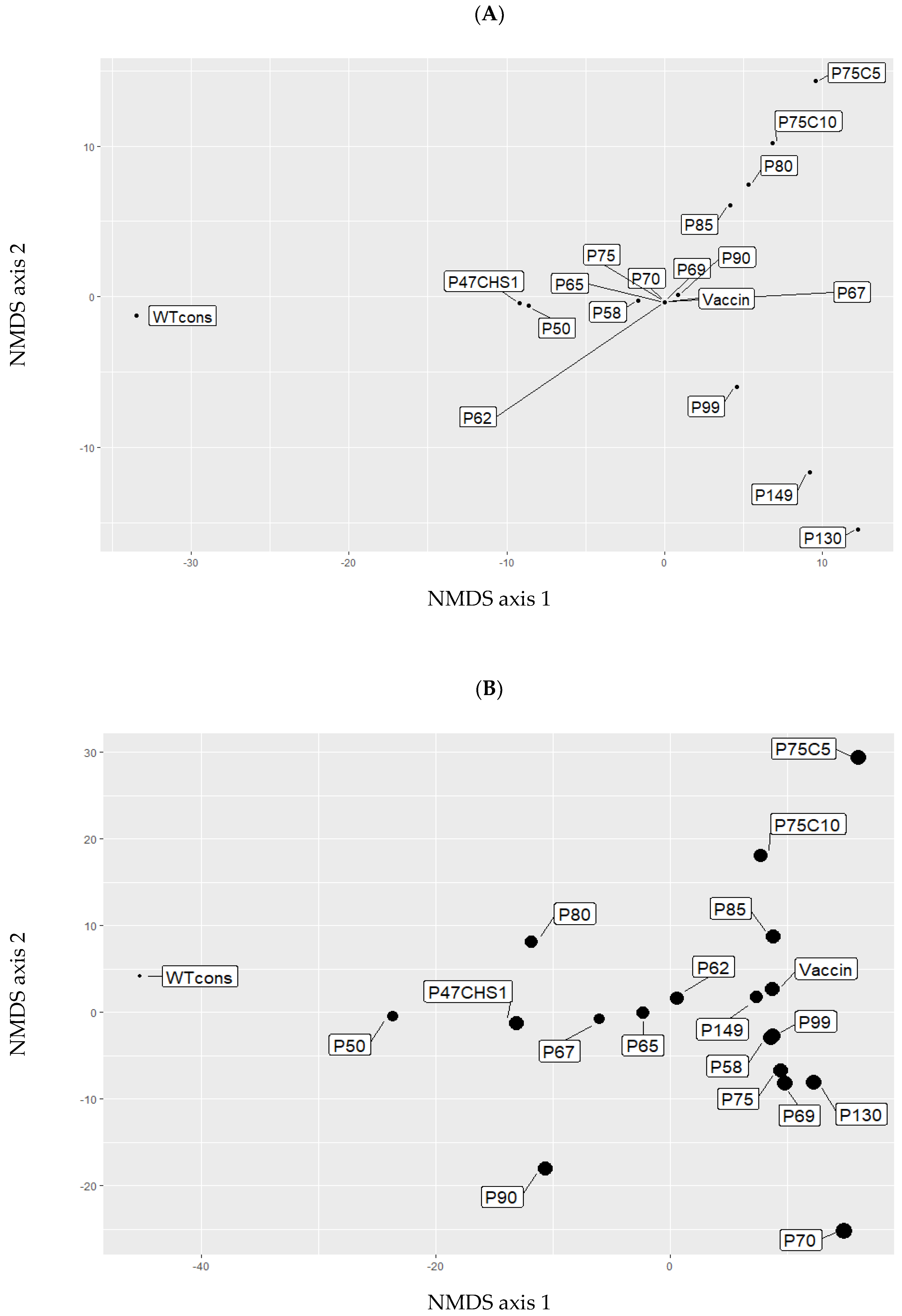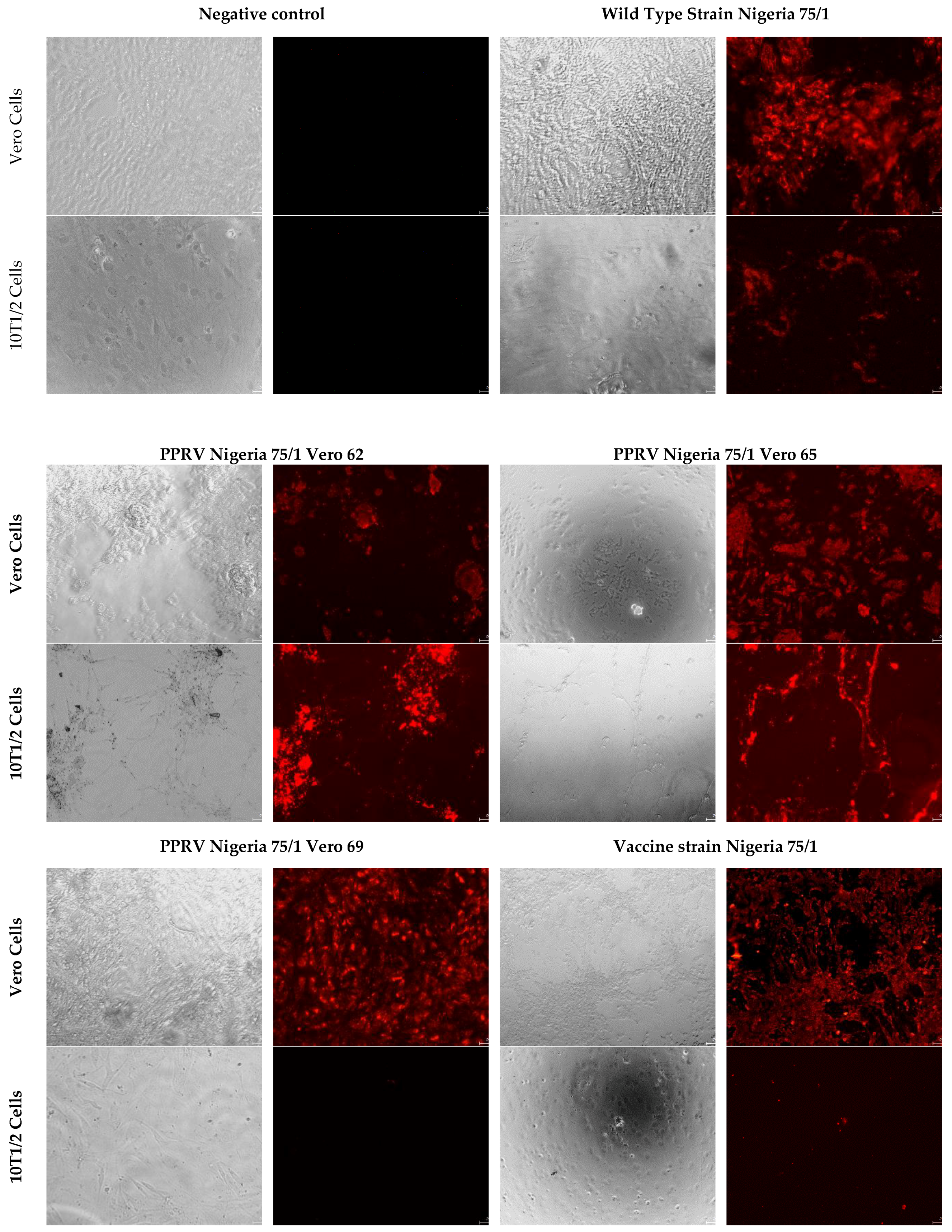Evolution of Attenuation and Risk of Reversal in Peste des Petits Ruminants Vaccine Strain Nigeria 75/1
Abstract
1. Introduction
2. Material and Methods
2.1. Viral Strains
2.2. Cell Culture Passages
2.3. High Throughput Genome Sequencing of PPR Virus Populations
2.4. Bioinformatic Analyses
2.5. Immunofluorescence on 10T1/2 Cells
3. Results
3.1. Comparison of Consensus Genome between PPRV Wild Type and Vaccine Nigeria 75/1 Strain
3.2. Appearance of Variants in Intermediate Attenuation Passages
3.3. Appearance of Genetic Variants in Passages after the Vaccine Master Seed
3.4. In Vitro Infection of 10T1/2 Cell Line
4. Discussion
Supplementary Materials
Author Contributions
Acknowledgments
Conflicts of Interest
References
- Kumar, N.; Maherchandani, S.; Kashyap, S.; Singh, S.; Sharma, S.; Chaubey, K.; Ly, H. Peste des petits ruminants virus infection of small ruminants: A comprehensive review. Viruses 2014, 6, 2287–2327. [Google Scholar] [CrossRef] [PubMed]
- Jones, B.A.; Rich, K.M.; Mariner, J.C.; Anderson, J.; Jeggo, M.; Thevasagayam, S.; Cai, Y.; Peters, A.R.; Roeder, P. The economic impact of eradicating peste des petits ruminants: A benefit-cost analysis. PLoS ONE 2016, 11, e0149982. [Google Scholar] [CrossRef] [PubMed]
- OIE; FAO. Global Control and Eradication of Peste des Petits Ruminants. 2015. Available online: http://www.fao.org/3/a-av222e.pdf (accessed on 6 August 19).
- Amarasinghe, G.K.; Bào, Y.; Basler, C.F.; Bavari, S.; Beer, M.; Bejerman, N.; Blasdell, K.R.; Bochnowski, A.; Briese, T.; Bukreyev, A.; et al. Taxonomy of the order Mononegavirales: Update 2017. Arch. Virol. 2017, 162, 2493–2504. [Google Scholar] [CrossRef] [PubMed]
- Parida, S.; Muniraju, M.; Mahapatra, M.; Muthuchelvan, D.; Buczkowski, H.; Banyard, A.C. Peste des petits ruminants. Vet. Microbiol. 2015, 181, 90–106. [Google Scholar] [CrossRef] [PubMed]
- Battisti, A.J.; Meng, G.; Winkler, D.C.; McGinnes, L.W.; Plevka, P.; Steven, A.C.; Morrison, T.G.; Rossmann, M.G. Structure and assembly of a paramyxovirus matrix protein. Proc. Natl. Acad. Sci. USA 2012, 109, 13996–14000. [Google Scholar] [CrossRef] [PubMed]
- Baron, M.D.; Banyard, A.C.; Parida, S.; Barrett, T. The Plowright vaccine strain of Rinderpest virus has attenuating mutations in most genes. J. Gen. Virol. 2005, 86, 1093–1101. [Google Scholar] [CrossRef]
- Griffin, D.E. Measles Vaccine. Viral Immunol. 2018, 31, 86–95. [Google Scholar] [CrossRef] [PubMed]
- Taylor, W.P.; Abegunde, A. The isolation of peste des petits ruminants virus from Nigerian sheep and goats. Res. Vet. Sci. 1979, 26, 94–96. [Google Scholar] [CrossRef]
- Diallo, A.; Taylor, W.P.; Lefèvre, P.C.; Provost, A. Atténuation d’une souche de virus de la peste des petits ruminants: Candidat pour un vaccin homologue vivant. Rev. Elev. Pays Trop. 1989, 42, 311–319. [Google Scholar]
- Takeuchi, K.; Miyajima, N.; Kobune, F.; Tashiro, M. Comparative nucleotide sequence analyses of the entire genomes of B95a cell-isolated and vero cell-isolated measles viruses from the same patient. Virus Genes 2000, 20, 253–257. [Google Scholar] [CrossRef]
- Bankamp, B.; Takeda, M.; Zhang, Y.; Xu, W.; Rota, P.A. Genetic Characterization of Measles Vaccine Strains. J. Infect. Dis. 2011, 204, S533–S548. [Google Scholar] [CrossRef] [PubMed]
- Enchery, F.; Hamers, C.; Kwiatek, O.; Gaillardet, D.; Montange, C.; Brunel, H.; Goutebroze, S.; Philippe-Reversat, C.; Libeau, G.; Hudelet, P.; et al. Development of a PPRV challenge model in goats and its use to assess the efficacy of a PPR vaccine. Vaccine 2019, 37, 1667–1673. [Google Scholar] [CrossRef] [PubMed]
- OIE. Peste des petits ruminants (infection par le virus de la peste des petits ruminants). In Manuel des Tests de Diagnostic et des Vaccins pour les Animaux Terrestres; OIE: Paris, France, 2019; Available online: http://www.oie.int/fileadmin/Home/fr/Health_standards/tahm/3.07.09_PPR.pdf (accessed on 6 August 19).
- Lokugamage, N.; Ikegami, T. Genetic stability of Rift Valley fever virus MP-12 vaccine during serial passages in culture cells. Npj Vaccines 2017, 2, 20. [Google Scholar] [CrossRef] [PubMed]
- Parameswaran, P.; Wang, C.; Trivedi, S.B.; Eswarappa, M.; Montoya, M.; Balmaseda, A.; Harris, E. Intrahost Selection Pressures Drive Rapid Dengue Virus Microevolution in Acute Human Infections. Cell Host Microbe 2017, 22, 400–410. [Google Scholar] [CrossRef] [PubMed]
- Ehrbar, D.J.; Ngo, K.A.; Campbell, S.R.; Kramer, L.D.; Ciota, A.T. High levels of local inter- and intra-host genetic variation of West Nile virus and evidence of fine-scale evolutionary pressures. Infect. Genet. Evol. 2017, 51, 219–226. [Google Scholar] [CrossRef] [PubMed]
- Satharasinghe, D.A.; Murulitharan, K.; Tan, S.W.; Yeap, S.K.; Munir, M.; Ideris, A.; Omar, A.R. Detection of Inter-Lineage Natural Recombination in Avian Paramyxovirus Serotype 1 Using Simplified Deep Sequencing Platform. Front. Microbiol. 2016, 7, 1907. [Google Scholar] [CrossRef] [PubMed]
- Stapleford, K.A.; Moratorio, G.; Henningsson, R.; Chen, R.; Matheus, S.; Enfissi, A.; Weissglas-Volkov, D.; Isakov, O.; Blanc, H.; Mounce, B.C.; et al. Whole-Genome Sequencing Analysis from the Chikungunya Virus Caribbean Outbreak Reveals Novel Evolutionary Genomic Elements. PLoS Negl. Trop. Dis. 2016, 10, e0004402. [Google Scholar] [CrossRef] [PubMed]
- Carmelato, J.; Albina, E.; Puech, C.; Franco, A.; Minet, C.; Servan de Almeida, R. Identification of a murine cell line that distinguishes virulent from attenuated isolates of the morbillivirus Peste des Petits Ruminants, a promising tool for virulence studies. Viruses Spec. Morbillivirus Infect 2019. Submitted. [Google Scholar]
- Adombi, C.M.; Lelenta, M.; Lamien, C.E.; Shamaki, D.; Koffi, Y.M.; Traoré, A.; Silber, R.; Couacy-Hymann, E.; Bodjo, S.C.; Djaman, J.A.; et al. Monkey CV1 cell line expressing the sheep—Goat SLAM protein: A highly sensitive cell line for the isolation of peste des petits ruminants virus from pathological specimens. J. Virol. Methods 2011, 173, 306–313. [Google Scholar] [CrossRef]
- Freeman, K.P.; Castro, A.E.; Kautz, C.E. Unusual characteristics of a parvovirus isolated from a clinically ill steer. Vet. Microbiol. 1986, 11, 61–68. [Google Scholar] [CrossRef]
- Cheng, E.; Mir, M.A. Signatures of host mRNA 5’ terminus for efficient hantavirus cap snatching. J. Virol. 2012, 86, 10173–10185. [Google Scholar] [CrossRef] [PubMed]
- Li, H.; Handsaker, B.; Wysoker, A.; Fennell, T.; Ruan, J.; Homer, N.; Marth, G.; Abecasis, G.; Durbin, R.; 1000 Genome Project Data Processing Subgroup. The Sequence Alignment/Map format and SAMtools. Bioinformatics 2009, 25, 2078–2079. [Google Scholar] [CrossRef] [PubMed]
- Garrison, E.; Marth, G. Haplotype-based variant detection from short-read sequencing. arXiv 2012, arXiv:12073907Q-Bio. [Google Scholar]
- Höper, D.; Freuling, C.M.; Müller, T.; Hanke, D.; von Messling, V.; Duchow, K.; Beer, M.; Mettenleiter, T.C. High definition viral vaccine strain identity and stability testing using full-genome population data—The next generation of vaccine quality control. Vaccine 2015, 33, 5829–5837. [Google Scholar] [CrossRef] [PubMed]
- Libeau, G.; Lefevre, P.C. Comparison of rinderpest and peste des petits ruminants viruses using anti-nucleoprotein monoclonal antibodies. Vet. Microbiol. 1990, 25, 1–16. [Google Scholar] [CrossRef]
- Baldo, A.; Galanis, E.; Tangy, F.; Herman, P. Biosafety considerations for attenuated measles virus vectors used in virotherapy and vaccination. Hum. Vaccines Immunother. 2016, 12, 1102–1116. [Google Scholar] [CrossRef] [PubMed]
- Ayata, M.; Komase, K.; Shingai, M.; Matsunaga, I.; Katayama, Y.; Ogura, H. Mutations Affecting Transcriptional Termination in the P Gene End of Subacute Sclerosing Panencephalitis Viruses. J. Virol. 2002, 76, 13062–13068. [Google Scholar] [CrossRef] [PubMed][Green Version]
- Takeda, M.; Ohno, S.; Tahara, M.; Takeuchi, H.; Shirogane, Y.; Ohmura, H.; Nakamura, T.; Yanagi, Y. Measles Viruses Possessing the Polymerase Protein Genes of the Edmonston Vaccine Strain Exhibit Attenuated Gene Expression and Growth in Cultured Cells and SLAM Knock-In Mice. J. Virol. 2008, 82, 11979–11984. [Google Scholar] [CrossRef]
- Le Nouën, C.; McCarty, T.; Brown, M.; Smith, M.L.; Lleras, R.; Dolan, M.A.; Mehedi, M.; Yang, L.; Luongo, C.; Liang, B.; et al. Genetic stability of genome-scale deoptimized RNA virus vaccine candidates under selective pressure. Proc. Natl. Acad. Sci. USA 2017, 114, E386–E395. [Google Scholar] [CrossRef]
- Li, P.; Ke, X.; Wang, T.; Tan, Z.; Luo, D.; Miao, Y.; Sun, J.; Zhang, Y.; Liu, Y.; Hu, Q.; et al. Zika Virus Attenuation by Codon Pair Deoptimization Induces Sterilizing Immunity in Mouse Models. J. Virol. 2018, 92, e00701-18. [Google Scholar] [CrossRef]
- Nogales, A.; Baker, S.F.; Ortiz-Riano, E.; Dewhurst, S.; Topham, D.J.; Martinez-Sobrido, L. Influenza A Virus Attenuation by Codon Deoptimization of the NS Gene for Vaccine Development. J. Virol. 2014, 88, 10525–10540. [Google Scholar] [CrossRef]
- Sidhu, M.S.; Chan, J.; Kaelin, K.; Spielhofer, P.; Radecke, F.; Schneider, H.; Masurekar, M.; Dowling, P.C.; Billeter, M.A.; Udem, S.A. Rescue of Synthetic Measles Virus Minireplicons: Measles Genomic Termini Direct Efficient Expression and Propagation of a Reporter Gene. Virology 1995, 208, 800–807. [Google Scholar] [CrossRef]
- Takeda, M.; Ohno, S.; Seki, F.; Nakatsu, Y.; Tahara, M.; Yanagi, Y. Long Untranslated Regions of the Measles Virus M and F Genes Control Virus Replication and Cytopathogenicity. J. Virol. 2005, 79, 14346–14354. [Google Scholar] [CrossRef]
- Harcourt, B.H.; Tamin, A.; Halpin, K.; Ksiazek, T.G.; Rollin, P.E.; Bellini, W.J.; Rota, P.A. Molecular Characterization of the Polymerase Gene and Genomic Termini of Nipah Virus. Virology 2001, 287, 192–201. [Google Scholar] [CrossRef]
- Parks, C.L.; Lerch, R.A.; Walpita, P.; Wang, H.-P.; Sidhu, M.S.; Udem, S.A. Analysis of the Noncoding Regions of Measles Virus Strains in the Edmonston Vaccine Lineage. J. Virol. 2001, 75, 921–933. [Google Scholar] [CrossRef]
- Hyde, J.L.; Gardner, C.L.; Kimura, T.; White, J.P.; Liu, G.; Trobaugh, D.W.; Huang, C.; Tonelli, M.; Paessler, S.; Takeda, K.; et al. A Viral RNA Structural Element Alters Host Recognition of Nonself RNA. Science 2014, 343, 783–787. [Google Scholar] [CrossRef]
- Baron, J.; Bin-Tarif, A.; Herbert, R.; Frost, L.; Taylor, G.; Baron, M.D. Early changes in cytokine expression in peste des petits ruminants disease. Vet. Res. 2014, 45, 22. [Google Scholar] [CrossRef]
- Adu, F.D.; Joannis, T.; Nwosuh, E.; Abegunde, A. Pathogenicity of attenuated peste des petits ruminants virus in sheep and goats. Rev. Elev. Med. Vet. Pays Trop. 1990, 43, 23–26. [Google Scholar]
- Klitting, R.; Riziki, T.; Moureau, G.; Piorkowski, G.; Gould, E.A.; de Lamballerie, X. Exploratory re-encoding of yellow fever virus genome: New insights for the design of live-attenuated viruses. Virus Evol. 2018, 4. [Google Scholar] [CrossRef]




| Mutations | Regions | POS | Passages | ||||||||||
|---|---|---|---|---|---|---|---|---|---|---|---|---|---|
| Wild Type | Vero 47 CHS1 | Vero 50 | Vero 58 | Vero 62 | Vero 65 | Vero 67 | Vero 69 | Vero 70 | Vero 75 | Vaccin CIRAD | |||
| 1 | Leader | 5* | A | . | . | . | . | A/G | A => G | . | . | . | . |
| 2 | Leader | 36 | A | A => G (100%) | . | . | A/G (3%)(97%) | A/G (0%)(100%) | . | A/G (2%)(98%) | A/G (100%) | A/G (2%)(97%) | A/G (14%) (85%) |
| 3 | N CDS | 221 | T | T => C (100%) | . | . | . | . | . | . | . | . | . |
| 4 | N CDS | 1513 | T | T => C (100%) L => P | . | . | . | . | . | . | . | . | . |
| 5 | P mRNA | 1795 | C | C => T (99%) | . | . | . | . | . | . | . | . | . |
| 6 | P CDS | 3158 | G | G => A (99%) G => E | . | . | . | . | . | . | . | . | . |
| 7 | M CDS | 3694 | A | A => G (100%) K => R | . | . | . | . | . | . | . | . | . |
| 8 | M CDS | 4046 | A | A => C (1%) (99%) R => S | . | . | . | . | . | . | . | . | . |
| 9 | M mRNA | 4559 | G | G => A (100%) | . | . | . | . | . | . | . | . | . |
| 10 | F CDS | 5627 | A | . | A => G (14%)(85%) | A/G (4%) (96%) | . | . | . | . | . | . | . |
| 11 | F CDS | 6422 | A | A => C (100%) K => E | . | . | . | . | . | . | . | . | . |
| 12 | F CDS | 6846 | A | . | A/G (68%)(32%) | A => G (1%) (99%) | . | . | . | . | . | . | . |
| 13 | H CDS | 7384 | A | A => C (100%) N => T | A/C (3%) (97%) | . | . | . | . | . | . | . | . |
| 14 | H CDS | 8645 | C | . | C/T (91%) (9%) | C => T (4%) (96%) | . | . | . | . | . | . | . |
| 15 | H CDS | 8829 | C | . | . | C/A (74%) (26%) | C => A (100%) R => S | C/A (17%)(83%) | C/A (3%) (97%) | . | . | . | . |
| 16 | L CDS | 12193 | A | A => C (100%) D => A | . | . | . | . | . | . | . | . | . |
| 17 | L CDS | 15777 | G | G => A (100%) D => N | . | . | . | . | . | . | . | . | . |
| 18 | Trailer | 15946* | C | / | / | C => G | . | . | . | . | . | . | . |
| Mutations | Regions | POS | Passages | ||||||||
|---|---|---|---|---|---|---|---|---|---|---|---|
| Vaccin CIRAD | Vero 75 CHS 5 | Vero 75 CHS 10 | Vero 80 | Vero 85 | Vero 90 | Vero 99 | Vero 130 | Vero 149 | |||
| 1 | Leader | 5 | G | / | / | / | / | / | / | / | / |
| 2 | Leader | 36 | A/G (14%) (85%) | A/G (30%) (70%) | A/G (33%) (67%) | A/G (9%) (90%) | A/G (13%) (87%) | A/G (4%)(95%) | A/G (7%) (93%) | A/G (3%) (97%) | . |
| 3 | N CDS | 221 | C | . | . | . | . | . | . | . | . |
| 4 | N CDS | 1513 | C | . | . | . | . | . | . | . | . |
| 5 | P mRNA | 1795 | T | . | . | . | . | . | . | . | . |
| 6 | P CDS | 3158 | A | . | . | . | . | . | . | . | . |
| 7 | M CDS | 3694 | G | . | . | . | . | . | . | . | . |
| 8 | M CDS | 4046 | C | . | . | A/C (8%) (91%) | A/C (100%) | A/C (4%)(96%) | A/C (100%) | . | . |
| 9 | M mRNA | 4559 | A | . | . | . | . | . | . | . | . |
| 10 | F CDS | 5627 | G | . | . | A/G (2%) (98%) | A/G (100%) | . | . | . | . |
| 11 | F CDS | 6422 | C | . | . | . | . | . | . | . | . |
| 12 | F CDS | 6846 | G | . | . | . | . | . | . | . | . |
| 13 | H CDS | 7384 | C | . | . | . | . | . | . | . | . |
| 14 | H CDS | 8645 | T | . | . | . | . | . | . | . | . |
| 15 | H CDS | 8829 | A | . | . | . | . | . | . | . | . |
| 16 | L CDS | 12193 | C | . | . | . | . | . | . | . | . |
| 17 | L CDS | 15777 | A | . | . | . | . | . | . | . | . |
| 18 | Trailer | 15946 | G | / | / | / | / | / | / | / | / |
© 2019 by the authors. Licensee MDPI, Basel, Switzerland. This article is an open access article distributed under the terms and conditions of the Creative Commons Attribution (CC BY) license (http://creativecommons.org/licenses/by/4.0/).
Share and Cite
Eloiflin, R.-j.; Boyer, M.; Kwiatek, O.; Guendouz, S.; Loire, E.; Servan de Almeida, R.; Libeau, G.; Bataille, A. Evolution of Attenuation and Risk of Reversal in Peste des Petits Ruminants Vaccine Strain Nigeria 75/1. Viruses 2019, 11, 724. https://doi.org/10.3390/v11080724
Eloiflin R-j, Boyer M, Kwiatek O, Guendouz S, Loire E, Servan de Almeida R, Libeau G, Bataille A. Evolution of Attenuation and Risk of Reversal in Peste des Petits Ruminants Vaccine Strain Nigeria 75/1. Viruses. 2019; 11(8):724. https://doi.org/10.3390/v11080724
Chicago/Turabian StyleEloiflin, Roger-junior, Marie Boyer, Olivier Kwiatek, Samia Guendouz, Etienne Loire, Renata Servan de Almeida, Geneviève Libeau, and Arnaud Bataille. 2019. "Evolution of Attenuation and Risk of Reversal in Peste des Petits Ruminants Vaccine Strain Nigeria 75/1" Viruses 11, no. 8: 724. https://doi.org/10.3390/v11080724
APA StyleEloiflin, R.-j., Boyer, M., Kwiatek, O., Guendouz, S., Loire, E., Servan de Almeida, R., Libeau, G., & Bataille, A. (2019). Evolution of Attenuation and Risk of Reversal in Peste des Petits Ruminants Vaccine Strain Nigeria 75/1. Viruses, 11(8), 724. https://doi.org/10.3390/v11080724





